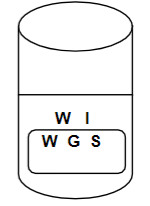How Will You Know Whether Starch Has Diffused Across the Membrane in Part a
ii.1: Membrane Protocol
- Page ID
- 25082
Each cell is surrounded by a selectively permeable cell membrane which regulates what gets into and out of the cell. A selectively permeable membrane allows some types of molecules and ions to diffuse across the membrane and prevents other types of molecules and ions from crossing the membrane. For example, oxygen can cross the selectively permeable cell membrane, simply large molecules similar proteins and Dna cannot cross the cell membrane.
1. Why is it useful for each jail cell to be surrounded past a selectively permeable jail cell membrane?
Today you lot will investigate a constructed selectively permeable membrane which provides a simplified model of the cell membrane. Specifically, y'all will test the hypothesis that smaller molecules and ions can cantankerous this synthetic selectively permeable membrane, but larger molecules cannot.
2. Which of the following molecules exercise you call up will diffuse across the selectively permeable membrane?
| Molecule or Ion (Molecular Formula) | Will information technology Cross the Membrane? | Why or Why Not? |
| Iodine (I3 -) | ||
| Water (H2O) | ||
| Glucose (CsixH12O6) | ||
| Starch (polysaccharide fabricated upwardly of many molecules of glucose) |
To exam your predictions, you will put solutions of starch and glucose in a bag fabricated of the synthetic membrane and put the bag in a beaker of iodine solution. You will allow time for the substances to diffuse across the membrane and and so exam which of the substances accept crossed the membrane.
3. The Initial State diagram shows the locations of each type of molecule or ion at the offset of the experiment. Based on your answers to question 2, predict where each type of molecule or ion will be found afterwards improvidence. In the Terminal State diagram, write the letter for each blazon of molecule or ion in the places where you think it will be plant at the cease of the experiment.

Notation
A assuming number on the left indicates a question you should reply.
To test whether iodine or starch have crossed the synthetic membrane, y'all will await for a change in color. A solution of iodine is tan and a solution of starch is clear or milky white; when iodine and starch are together in the aforementioned solution, the solution is purple, dark blue or black. To test whether glucose has crossed the constructed membrane, you lot will employ a glucose test strip to examination for glucose in the solution in the chalice. If h2o can cross the synthetic membrane, water could lengthened into the bag or out of the bag. Your instructor will let yous know how you will test for change in volume of h2o in the bag.
4. For each substance, bespeak how yous will know whether it crossed the synthetic membrane. What observation volition exist dissimilar, depending on whether or non each substance crossed the membrane?
| Substance | Expected Observation | |
| If this substance crossed the membrane. | If this substance did non cantankerous the membrane. | |
| Iodine | ||
| Starch | ||
| Glucose | ||
| Water | ||
Procedure:
- Obtain a piece of pre-soaked dialysis tubing and two pieces of cord. Fold the bottom of the slice of tubing 1 cm up and use a slice of string to tie the folded part tightly to create a bag.
- To open up the other end of the tube, rub the cease between your fingers until the edges carve up. Use pipettes to add 4 mL of glucose solution and iv mL of starch solution to the tube.
- Adjacent, fold one cm of tubing at the top of the handbag and necktie it off tightly. Check to make sure in that location are no leaks. If scissors are bachelor, trim the strings short.
- Rinse the purse and strings thoroughly in fresh water. Dry out the bag and strings thoroughly.
- In the tabular array below record your initial observation of the measure y'all are using to evaluate the movement of water.
- Add 200 mL of distilled water to a 250 mL chalice. Add most 0.8 mL iodine to the water in the beaker.
Annotation
The platonic gas law is easy to call up and apply in solving problems, as long as you get the proper values a
- Put the bag in the beaker.
five. Record your observations of the colors of the solution in the handbag and the solution in the chalice in the "Initial State" row in the table below.
| In the Purse | In the Beaker | Measure to Evaluate Move of H2o | ||||
| Color | Glucose? | Color | Glucose? | |||
| Initial Country | Yeah | No | ||||
| Final State | Aye | |||||
Yous will need to wait xx-30 minutes for substances to move across the selectively permeable membrane. While you lot're waiting, read the following paragraph and answer question 6.
Osmosis is the move of water across a selectively permeable membrane. Osmosis results in the net movement of water from a solution with a lower concentration of solutes to a solution with a college concentration of solutes. In your experiment, the concentration of solutes is higher in the starch and glucose solution in the bag than in the iodine solution in the beaker.
6. Which way would you wait more water to diffuse – into the bag or out of the bag? Explain why.
Later on 20-30 minutes, record your observations in the "Final State" row of the table on the bottom of folio 2.
7. Complete this table.
| Molecule or Ion (Molecular Formula) | Did this Molecule or Ion Cantankerous the Membrane? | How exercise you Know? |
| Iodine (I3 -) | ||
| Water (H2O) | ||
| Glucose (CsixH12O6) | ||
| Starch (polysaccharide fabricated up of many molecules of glucose) |
8. Based on your results, what characteristic appears to determine which molecules and ions can cross the synthetic selectively permeable membrane?
9a. Did whatsoever of your results differ from your predictions in questions 3 and 6? If then, what were the differences between your results and your predictions?
9b. What exercise you call up is the caption for any differences between your predictions and your observations?
A model is a simplified representation of a complex biological structure or process. A model focuses on a few central features in order to help united states of america understand a biological structure.
Because a model is simpler than the biological structure it represents, a model does not testify all the features of the actual biological structure. For instance, the synthetic membrane in your experiment is a model of the selectively permeable jail cell membrane, but it shows a much simpler kind of selective permeability than an actual cell membrane has.
This diagram provides a unlike model of the cell membrane. It gives some idea of the complexity of the selective permeability of an bodily cell membrane. The diagram shows that a jail cell membrane contains proteins that assistance in the transport of biologically of import ions and molecules across the cell membrane.

This activeness has presented two models of the selectively permeable cell membrane: this diagram and the synthetic membrane in your experiment. Both models bear witness that small molecules and ions can cross a selectively permeable membrane. Withal, in that location are some differences in other features of these models.
10. The fourth type of transport shown in the diagram is observed in living cells, but not in a synthetic membrane. Explain why this blazon of transport is possible in living cells, but not in a synthetic membrane.
11. Which feature of cell membranes was demonstrated by your experiment with the synthetic membrane, simply is not shown in the diagram? (Hint: Recollect most starch.)
Source: https://bio.libretexts.org/Learning_Objects/Laboratory_Experiments/General_Biology_Labs/BCCC_MASTER_Biology_PLC/Biology_101/02._Membrane_Dynamics/2.1:_Membrane_Protocol

Post a Comment for "How Will You Know Whether Starch Has Diffused Across the Membrane in Part a"